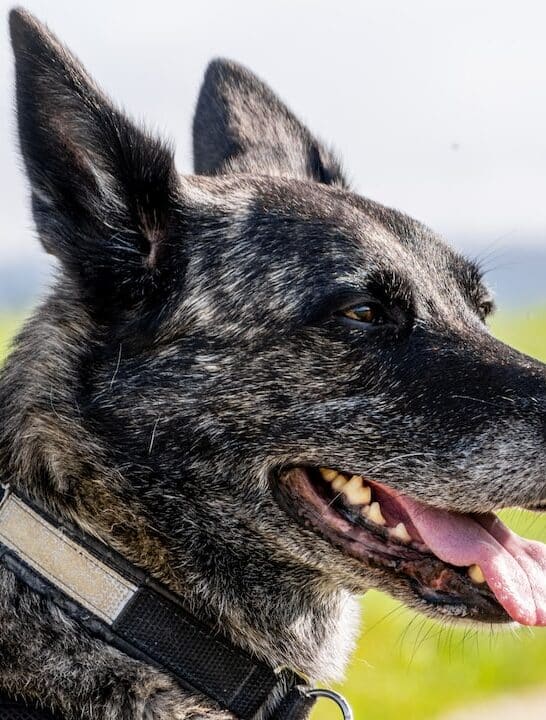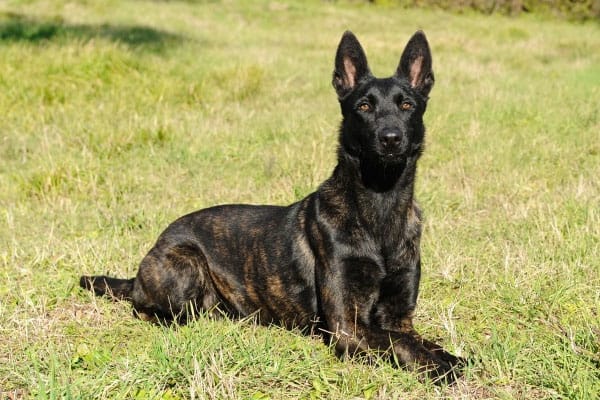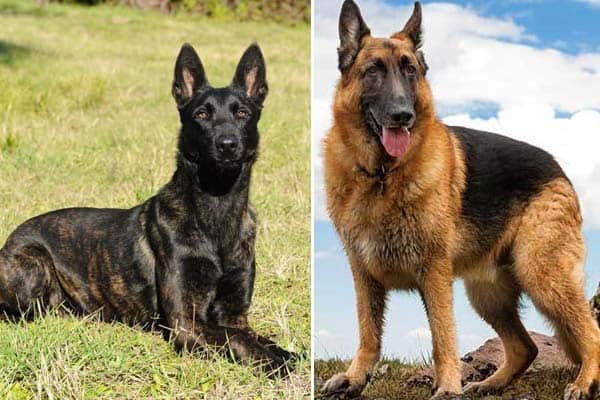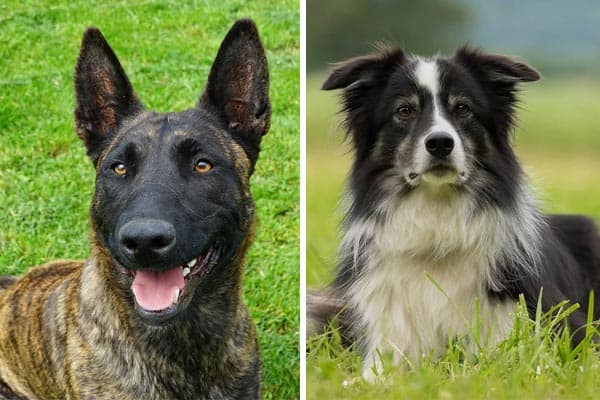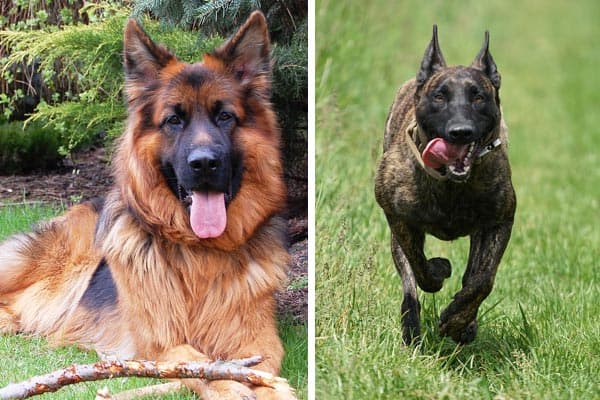Is the Dutch Shepherd Golden Retriever Mix a Fantastic Dog? What Is Your Best Guess
If someone told you she was going to buy a Dutch Shepherd, would you be able to imagine its appearance? I remember seeing the name years before I saw my first Dutchie.
Mixing a Dutch Shepherd with a Golden Retriever accomplishes the seemingly impossible task of creating an even more exotic dog than the elusive Dutchie.
What can you expect with a Dutch Shepherd Golden Retriever mix? You will get a medium-large dog about the size of a small German Shepherd. She will have blonde, honey, or brindle medium-long, slightly wavy hair with a full tail, ruff, and feathers on her legs and belly.
She will also be an efficient mover, a quick, athletic dog, and a water lover. She should be loyal and affectionate with a slight guarding tendency. Finally, she will be smart, trainable, and good with children and other dogs.
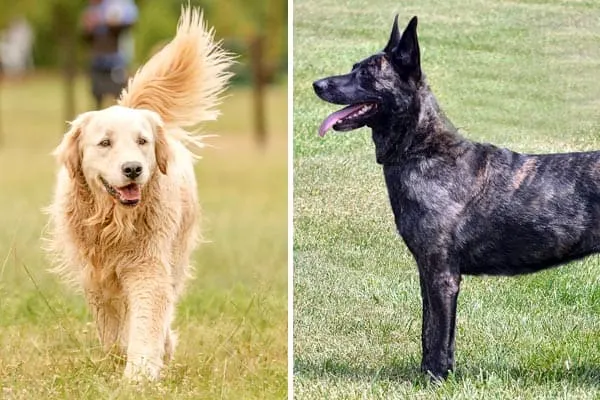
Where does the Dutch Shepherd Golden Retriever mix originate?
Most Dutch Shepherd Golden matings probably have specific goals because the DS is so uncommon. The Dutch Club is still working hard to revitalize the Dutch Shepherd breed. However, you can get a sense of what purposes your hybrid might fulfill based on a brief history.
The Dutch Shepherd originated in the southern area of the Netherlands close to Belgium’s border. Dutch Shepherds herded large flocks of sheep on vast heather meadows.
Like German Shepherds, the DS was a perimeter herder, mainly keeping sheep from going into forbidden or dangerous areas. However, to collect manure for fertilizer, shepherds began to train their dogs to drive the sheep to the barn at night.
Dutch Shepherds also learned to guard property and draw carts with supplies. The first Dutch Shepherd standard was written in 1898, but the breed’s separation from the Belgian Shepherds came some years later.
The two had already separated from the German Shepherd about 1892 when the Belgian Shepherd Club wrote their breed standard.
Images of Dutch Shepherds at various activities illustrate a distinct difference between them and the other Shepherds that extends beyond the brindle coloration.
Note the numerous types of brindle patterns and shades. You will also notice the Dutch Shepherd’s distinctive head and shape to the ears. Dutchies are smaller than German Shepherds with subtle differences in body form and gait.
Although much of the Golden Retriever’s history is well-documented, its origins are a bit mysterious.
According to AllGoldenRetriever, Scotland developed the breed from yellow Retrievers that were around at least as early as 1839. However, earlier dogs like a heavy-boned liver and white Setter and other setters and spaniels may have influenced the ancestors of the beloved Golden Retriever.
Regardless, the original purpose of the Golden was to hunt and retrieve birds in the Scottish highlands and marshlands. They developed a knack for fetching birds from land and water, the latter to which they took with enthusiasm.
Golden Retrievers entered the United Kennel registry in 1901.
You may not know the reason for the creation of your Dutch Shepherd Golden Retriever mix, but he is sure to excel at several activities.
- Agility (both)
- Obedience (Golden)
- Fly ball(DS) – Team relay event, dogs need to be fast and nimble.
- Disc/Frisbee (DS)
- Therapy (Golden)
- Search and rescue (both)
- Police/guard (DS)
- Shutzhunde (DS) – Dutch Shepherds excel at protective work, like the GSD.
- Dock diving (both)
- Lure coursing (DS) – A timed event, competing handlers, or the judge affix “bait” to a track, and the dog chases it. The lure stays just out of reach of the dog.
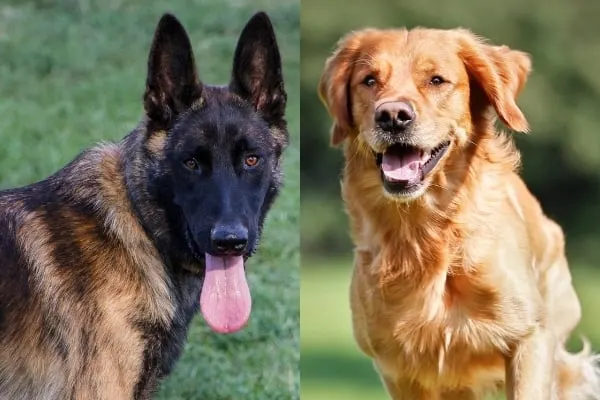
What is the Dutch Shepherd Golden Retriever mix breed standard?
Since a purebred Dutch Shepherd alone is rare and typically mixed with Belgian Malinois if at all, the Dutchie Golden mix is difficult to find.
However, Golden Retrievers are so common that if you look hard enough, you can find a mix that might include a Dutch Shepherd. Even more difficult is picturing how such a cross might look.
You can generate a reasonable image of a Dutch Shepherd Golden Retriever by drawing the two breeds side by side armed with your knowledge of how other mixes turn out. Not all puppies will be a perfect 50:50 blend of the two parents, but the Dutchie and Golden are similar enough to produce some consistency.
The Dutch Shepherd Golden Retriever mix is a large dog with a well-proportioned frame. Her face looks exotic with the wedge-shaped head and wide-spaced eyes from the Dutch Shepherd and broad cheeks and pleasant expression of the Golden. The ears can be drop or semi-prick.
Size
Dutch Shepherds and Golden Retrievers are almost identical in size. The Dutchie male is 22 to 25 inches tall, and the females are 21 to 24 inches at the shoulders. Both sexes weigh about 50 to 70 pounds.
The UKC and AKC standard for the Golden Retriever specify a dog that is 21.5 to 22.5 inches tall for females and 23 to 24 inches for males. The American Kennel allows a one-inch leeway for both genders in either direction before disqualification. Goldens weigh 55 to 75 pounds.
Dutch Shepherd Golden Retriever puppies may be slightly smaller or somewhat larger than their parents as adults. Your dog will probably be 21 to 26 inches tall at the shoulders and weigh 48 to 80 pounds.
General Appearance
Your first impression of a Golden Retriever should be of a friendly, happy, and self-confident dog.
Goldens have a solid build with good muscling. One of their most recognizable and breed-specific characteristics is their head, which is broad between the ears with friendly and intelligent eyes. Said eyes are somewhat large and dark or medium brown with dark rims.
Their ears are small relative to their skulls and lay close to their cheeks. A Golden Retriever’s stop is pronounced but gradual from the forehead to the straight and moderately deep muzzle.
A Golden has a deep and broad chest and straight back with very little tuck-up of the belly. Her tail extends to the hocks, but generally, she carries it level with her back. A Golden Retriever’s tail should contribute to the overall joyous impression of the dog. Her gait is powerful and reaching.
Dutch Shepherds are steadfast, animated, and work-oriented.
A Dutchie has a wedge-shaped, somewhat elongated head. The skull is fairly flat with only a slight stop, a significant deviation from the similar German Shepherd. Eyes should be dark, medium in size, almond-shaped, and set at a slight slant.
A Dutch Shepherd’s ears are rather small in relation to his head and stand upright, usually a little forward of the vertical plane.
Dutch Shepherds are dogs built to work long hours at the trot with short bursts of speed. They have an efficient and supple gait with no flashiness.
A Dutch Shepherd shows a balance in motion with a stride that neither reaches very far forward nor floats like some other Shepherds.
Dutch Shepherds’ bodies are proportionate in all areas with a straight back and relative length: height ratio of 10:9. The chest is deep and moderately broad.
A Dutchie’s tail reaches just to the hocks, either hanging straight or curving slightly upward at the tip. When a Dutch Shepherd is working, she often carries her tail just below or at the level of the back.
A Dutch Shepherd Golden Retriever mix will have a well-balanced, muscled, medium-sized body with a straight and powerful back, strong neck, and moderately deep and somewhat wide chest. He will have a springy and fluid gait at the trot and good speed at the run.
Your hybrid’s tail will extend to the hocks, and she will likely carry it in a joyful way like a Golden Retriever. She will give the impression of a friendly and relaxed dog with plenty of energy and a great work ethic.
Colors
Golden Retrievers are a golden color from cream to honey brown to deep brownish-gold. Dutch Shepherds are gold brindle or silver brindle with the occasional undesirable yellow dog.
Your Dutch Shepherd Golden Retriever mix will probably be brindle, fawn, or golden.
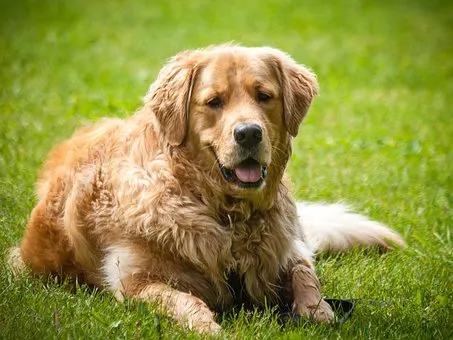
Is the Golden Dutch Shepherd mix a good family dog?
A dog’s disposition is unpredictable, especially for mixed breeds who can get any proportion of their personality from either parent. Fortunately, Dutch Shepherds and Golden Retrievers do not differ as much as you might expect.
Will your dog protect you?
You may think you need a big ferocious dog to provide effective protection of your home and family. Experts advise the opposite is true.
Guard dogs for most informal households should mainly have a commanding presence and only display aggression as a last resort. Most family guard dogs should not even feel a need to bite.
Golden Retrievers do not typically make effective watchdogs or guard dogs.
Although extremely loyal, Goldens are naturally friendly and not in the habit of barking at intruders. However, their large size is imposing and wards off most criminal intent. Moreover, their protective nature will bring them near you if there is a threat.
Golden retrievers are perceptive enough to try to interfere if you are in danger. They still will not likely bite.
Dutch Shepherds have a strong guarding instinct from generations of watching over flocks, but they are not particularly reactive or aggressive. Dutchies, like Goldens, have a loud voice but do not bark very often. Their presence is intimidating, and they will attack an intruder if they deem necessary.
Dutch Shepherds are easy to train in guard duty but will not need any encouragement in most households as they are protective of family and territory. They should receive extensive socialization, so they learn discretionary skills.
Your Dutch Shepherd Golden Retriever mix will likely be a fairly quiet dog with a strong presence that will be enough to ward off most people with any intent to harm.
They are not likely to react with aggression without extreme provocation. Most will bark to warn you of the approach of visitors or cars. For most households, the Dutch Shepherd Golden cross makes an ideal guard dog.
Dutch Shepherd Golden Retrievers are good with kids
Your Dutchie mix should be great with children, especially with the Golden Retriever. Goldens are generally gentle around young kids, and Dutch Shepherds may feel protective of them. There are only a few significant considerations.
- Large dog – You should never leave children under about the age of nine years unsupervised with big dogs. Dogs may deal with minor disagreements in a manner that would prove harmful to a small child.
- Young dogs may be overexuberant – Adolescent Goldens, especially, have little control over their enthusiasm and can knock toddlers to the ground or may jump upon them.
- Herding – Dutch Shepherds may feel compelled to herd small kids, especially if they are protective. Your hybrid may inherit some of these tendencies.
What about other pets?
Except for some Dutch Shepherd working lines, Dutchies and Golden Retrievers have a below-average prey drive.
Moreover, Dutch Shepherds historically worked with other dogs, and Golden Retrievers are good-natured and amiable, so your mix should do well with other canids.
With proper socialization, your Golden cross should also be able to tolerate cats. However, always use care mixing tiny animals with large dogs because cats and small dogs are vulnerable to severe injury.
Can you have your dog out around guests?
Although Dutchies can be a little reserved around strangers, most are friendly dogs. You are likely more familiar with the kind and outgoing personality of the highly popular Golden.
With some who seem to smile around new people, the Golden Retriever makes visitors look forward to seeing your dog.
Your Dutch Shepherd Golden Retriever mix may not be quite as outgoing as a purebred Golden, but you will be able to show her off during your dinner parties. Unlike some breeds that are friendly but aloof, your dog will likely enjoy the attention and allow your guests to shower her with affection.

How should you groom your Dutch Shepherd Golden Retriever Mix?
Dutch Shepherd has three coat types. All have a woolly undercoat, a densely furred tail, and a ruff of longer fur around the neck.
- Short-haired – The outer coat hairs lie flat and are hard.
- Long-haired – No fringes on the ears.
- Wire-haired or Rough-haired – The outer coat has a tousled curls appearance, often hiding the fact the dog is brindle.
Dutchies require regular brushing. The wire-haired variety needs hand stripping of the coat, which you can do with a particular type of comb or your hands.
Many Dutchie owners enlist the help of a professional groomer for stripping, which you should do every three to six months.
Golden Retrievers have moderately long hair neither soft nor coarse with a dense undercoat. A Golden’s coat is water-repellant.
According to AllGoldenRetriever, you need scissors, a comb, a brush, shears, and a blow dryer to groom your Golden properly. Golden Retrievers indeed have a high-maintenance coat, but fortunately, not everyone shows them.
You should largely plan on brushing your Golden a few times a week. Some owners shave their Goldens to their undercoats to avoid the time commitment. However, Retrievers are double-coated dogs who get protection from year-round elements from outer and undercoat.
Your Dutch Shepherd Golden Retriever will have a double coat of short to medium-long hair over a dense undercoat.
Since long-haired Dutch Shepherds are much rarer than short-haired dogs, you will likely not have a pet with exceedingly long hair.
He may have feathering on the belly, chest, and neck, and probably will have a full tail. He will be more likely to tangle than a purebred Dutchie.
You should brush your mix at least once or twice a week. Your Dutch Shepherd will blow his coat twice a year, in the fall and spring. You can bathe your dog every month to help with shedding, and blow-drying can help with dense coats and heavy shedders.
As with any dog, clip your Dutchie mix’s nails every six to eight weeks, check ears every couple of days, and brush teeth twice a week.
Do not neglect exercise
Dutch Shepherds require 90 to 120 minutes of exercise per day, and Goldens need at least 45 minutes daily.
Goldens, according to AllGoldenRetriever, exhibit more drastic differences than Dutch Shepherds between show and working lines, quite similar to the GSD.
Show line Goldens may only require half an hour of exercise daily, while field lines could need up to two hours of activity every day.
In this video, the dog illustrates how you can bond with your dog and accomplish mental stimulation and physical fitness in your dog at the same time.
It sometimes can be difficult to picture Golden Retrievers being athletic, but they are sporting gun dogs who historically worked as hard as their herding counterparts.
This Golden Retriever shows what an average pet can do, or perhaps he is just learning. You will note that some dogs work much faster and without hesitation.
Your Dutch Shepherd mix will probably do well with an hour and a half of exercise a day, mixing activities to give your dog mental stimulation and the opportunity to push herself to her physical limits. Most dogs do best with exercise split over two or more sessions.
Shorten the length of time and lessen the intensity of exercise for puppies under 12 to 16 months who are still growing.
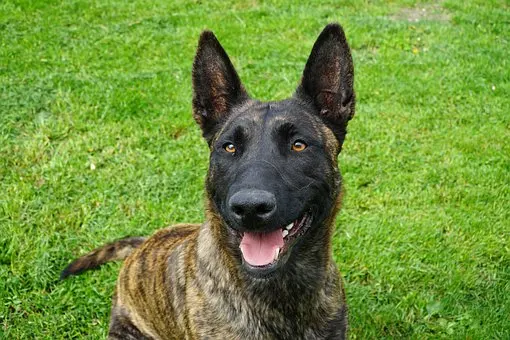
How long will your Dutchie Golden live?
Dutch Shepherds can live 12 to 15 years while Goldens have a lifespan ranging from 10 to 12 years. Looking to the most closely related mix we could find, the German Shepherd Golden Retriever, your dog will probably live 11 to 15 years.
Health issue your mixed puppy may inherit that could shorten his life or diminish its quality are as follows:
- Goniodysplasia (Dutch Shepherd) – A form of glaucoma, goniodysplasia causes the eyes to fill with fluid from lack of proper drainage. It may require surgical correction and can lead to blindness.
- Pannus
- Atopy (both) – Skin allergies that can cause itching and rashes.
- Inflammatory bowel disease(Dutch Shepherd) – Sometimes IBD is mistaken for sensitive stomach.
- Hip/Elbow dysplasia(Golden Retriever) – Dysplasia is not common in Dutch Shepherds. It is a painful developmental problem of the corresponding joint and often leads to arthritis.
- GDV/Bloat – A potential problem of large-breed deep-chested dogs, improper feeding practices can increase the risk. The stomach fills with gas in bloat and then twists, causing life-threatening changes to the heart and electrolytes.
- Ear infections (Golden Retriever) – Check ears regularly for redness, pain, odor, or discharge.
- Skin infections/disease (Golden Retriever)
- Von Willebrand’s (Golden Retriever) – A blood clotting disorder.
- Luxating patellas – The kneecaps are “loose” or slide off their tracks in the patellar groove.
- Cancer – Cancer, of course, affects all dogs, but according to Wapitilabsinc.com, Golden Retrievers suffer more than any other breed by far. A couple of the more common types are bone cancer and cancer of the lymphatic system (lymphosarcoma).

What can you expect of training and intelligence?
According to Thesmartcanine.com, Golden Retrievers rank in the top four most intelligent dogs behind the Border Collie, Poodle, and GSD. Most IQ lists regarding dogs base their reports on the respected work of dog psychologist Stanley Coren.
The Dutch Shepherd never received a rating because the breed was not a part of the AKC when Coren performed his studies.
Dutch Shepherds probably would rank between the Kuvasc (#42), an independent herding dog, and the Belgian Malinois (#22), with whom the DS shared close blood ties until 1914. This logic would estimate the Dutch Shepherd to rank in the top 30 to 20 most intelligent dogs based on obedience and working with humans.
Dutch Shepherds are loyal, willing to please, and bond very closely with their handlers. However, they require strong leadership qualities from their owners. Their independent backgrounds make them moderately stubborn, decreasing their trainability and obedience for novice owners.
With the Dutch Shepherd Golden mix, you will likely get an intelligent dog with excellent trainability. You should see a loyal dog who is willing to please and obedient. The degree of obedience may change if your pet inherits stubbornness from the Dutchie.














